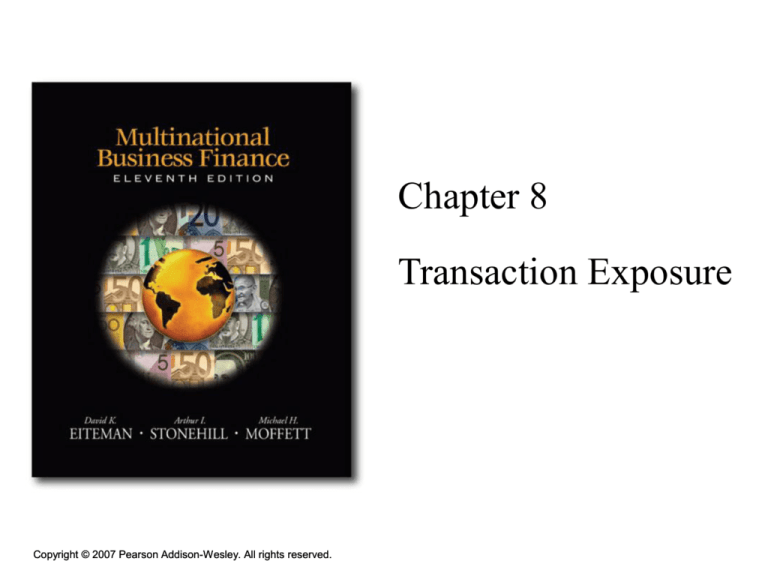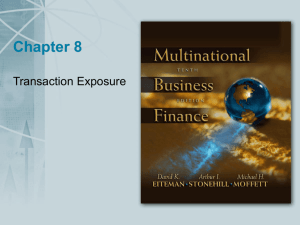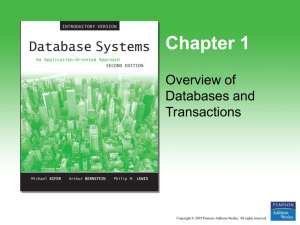
Chapter 8
Transaction Exposure
Copyright © 2007 Pearson Addison-Wesley. All rights reserved.
Transaction Exposure
• Foreign exchange exposure is a measure of the
potential for a firm’s profitability, net cash
flow, and market value to change because of a
change in exchange rates.
• An important task of the financial manager is
to measure foreign exchange exposure and to
manage it so as to maximize the profitability,
net cash flow, and market value of the firm.
• The effect on a firm when foreign exchange
rates change can be measured in several ways.
Copyright © 2007 Pearson Addison-Wesley. All rights reserved.
1-2
Exhibit 8.1 Conceptual Comparison of Transaction,
Operating and Accounting Foreign Exchange
Exposure
Moment in time when
exchange rate changes
Translation exposure
Changes in reported owners’ equity
in consolidated financial statements
caused by a change in exchange rates
Operating exposure
Change in expected future cash flows
arising from an unexpected change in
exchange rates
Transaction exposure
Impact of settling outstanding obligations entered into before change
in exchange rates but to be settled after change in exchange rates
Time
Copyright © 2007 Pearson Addison-Wesley. All rights reserved.
1-3
Types of Foreign
Exchange Exposure
• Transaction exposure measures changes
in the value of outstanding financial
obligations incurred prior to a change in
exchange rates but not due to be settled
until after the exchange rates change.
• Thus, this type of exposure deals with
changes in cash flows the result from
existing contractual obligations.
Copyright © 2007 Pearson Addison-Wesley. All rights reserved.
1-4
Types of Foreign
Exchange Exposure
• Operating exposure, also called
economic exposure, competitive
exposure, or strategic exposure,
measures the change in the present value
of the firm resulting from any change in
future operating cash flows of the firm
caused by an unexpected change in
exchange rates.
Copyright © 2007 Pearson Addison-Wesley. All rights reserved.
1-5
Types of Foreign
Exchange Exposure
• Accounting exposure, also called
translation exposure, is the potential for
accounting-derived changes in owner’s
equity to occur because of the need to
“translate” foreign currency financial
statements of foreign subsidiaries into a
single reporting currency to prepare
worldwide consolidated financial
statements.
Copyright © 2007 Pearson Addison-Wesley. All rights reserved.
1-6
Dayton Manufacturing’s
Transaction Exposure
• With reference to Dayton Manufacturing’s
Transaction Exposure, the CFO, Scout Finch,
has four alternatives:
– Remain unhedged;
– hedge in the forward market;
– hedge in the money market, or
– hedge in the options market.
• These choices apply to an account receivable
and/or an account payable.
Copyright © 2007 Pearson Addison-Wesley. All rights reserved.
1-7
Dayton Manufacturing’s
Transaction Exposure
• A forward hedge involves a forward (or futures)
contract and a source of funds to fulfill the contract.
• In some situations, funds to fulfill the forward
exchange contract are not already available or due to be
received later, but must be purchased in the spot market
at some future date.
• This type of hedge is “open” or “uncovered” and
involves considerable risk because the hedge must take
a chance on the uncertain future spot rate to fulfill the
forward contract.
• The purchase of such funds at a later date is referred to
as covering.
Copyright © 2007 Pearson Addison-Wesley. All rights reserved.
1-8
Dayton Manufacturing’s
Transaction Exposure
• A money market hedge also involves a contract and a source
of funds to fulfill that contract.
• In this instance, the contract is a loan agreement.
• The firm seeking the money market hedge borrows in one
currency and exchanges the proceeds for another currency.
• Funds to fulfill the contract – to repay the loan – may be
generated from business operations, in which case the
money market hedge is covered.
• Alternatively, funds to repay the loan may be purchased in
the foreign exchange spot market when the loan matures
(uncovered or open money market hedge).
Copyright © 2007 Pearson Addison-Wesley. All rights reserved.
1-9
Dayton Manufacturing’s
Transaction Exposure
• Hedging with options allows for
participation in any upside potential
associated with the position while
limiting downside risk.
• The choice of option strike prices is a
very important aspect of utilizing options
as option premiums, and payoff patterns
will differ accordingly.
Copyright © 2007 Pearson Addison-Wesley. All rights reserved.
1-10
Exhibit 8.5 Valuation of Cash Flows
Under Hedging Alternatives for Dayton
Value in US dollars of
Dayton’s £1,000,000 A/R
Uncovered
Put option strike
price of $1.75/£
1.84
OTM put
option hedge
Put option strike
price of $1.71/£
1.82
ATM put
option hedge
1.80
1.78
Money market hedge
1.76
1.74
Forward contract hedge
1.72
1.70
1.68
1.68
1.70
1.72
1.74
1.76
1.78
1.80
1.82
1.84
1.86
Ending spot exchange rate (US$/£)
Copyright © 2007 Pearson Addison-Wesley. All rights reserved.
1-11
Exhibit 8.6 Valuation of Hedging
Alternatives for an Account Payable
Cost in US dollars of
Dayton’s £1,000,000 A/P
Call option strike
price of $1.75/£
Uncovered costs
whatever the ending
spot rate is in 90 days
Forward rate
is $1.7540/£
1.84
1.82
Money market hedge
Locks in a cost of $1,781,294
1.80
1.78
1.76
1.74
Forward contract hedge
locks in a cost of $1,754,000
Call option hedge
1.72
1.70
1.68
1.68
1.70
1.72
1.74
1.76
1.78
1.80
1.82
1.84
1.86
Ending spot exchange rate (US$/£)
Copyright © 2007 Pearson Addison-Wesley. All rights reserved.
1-12
Risk Management in Practice
• The treasury function of most private firms, the
group typically responsible for transaction
exposure management, is usually considered a
cost center.
• The treasury function is not expected to add
profit to the firm’s bottom line.
• Currency risk managers are expected to err on
the conservative side when managing the firm’s
money.
Copyright © 2007 Pearson Addison-Wesley. All rights reserved.
1-13
Risk Management in Practice
• Firms must decide which exposures to hedge:
– Many firms do not allow the hedging of quotation
exposure or backlog exposure as a matter of policy
– Many firms feel that until the transaction exists on
the accounting books of the firm, the probability of
the exposure actually occurring is considered to be
less than 100%
– An increasing number of firms, however, are
actively hedging not only backlog exposures, but
also selectively hedging quotation and anticipated
exposures.
– Anticipated exposures are transactions for which
there are – at present – no contracts or agreements
between parties
Copyright © 2007 Pearson Addison-Wesley. All rights reserved.
1-14
Risk Management in Practice
• As might be expected, transaction exposure
management programs are generally
divided along an “option-line”; those that
use options and those that do not.
• Firms that do not use currency options rely
almost exclusively on forward contracts and
money market hedges.
Copyright © 2007 Pearson Addison-Wesley. All rights reserved.
1-15
Risk Management in Practice
• Many MNEs have established rather rigid
transaction exposure risk management policies
that mandate proportional hedging.
• These contracts generally require the use of
forward contract hedges on a percentage of
existing transaction exposures.
• The remaining portion of the exposure is then
selectively hedged on the basis of the firm’s
risk tolerance, view of exchange rate
movements, and confidence level.
Copyright © 2007 Pearson Addison-Wesley. All rights reserved.
1-16
Risk Management in Practice
• In addition to having required minimum
forward-cover percentages, many firms
also require full forward-cover when
forward rates “pay them the points.”
• The points on the forward rate is the
forward rate’s premium or discount.
Copyright © 2007 Pearson Addison-Wesley. All rights reserved.
1-17
Risk Management in Practice
• A further distinction in practice can be made
between those firms that buy currency options
(buy a put or buy a call) and those that both
buy and write currency options.
• Those firms that do use currency options are
generally more aggressive in their tolerance of
currency risk.
• However, in many cases firms that are
extremely risk-intolerant will utilize options to
hedge backlog and/or anticipated exposures.
Copyright © 2007 Pearson Addison-Wesley. All rights reserved.
1-18
Risk Management in Practice
• Since the writer of an option has a limited
profit potential with unlimited loss potential,
the risks associated with writing options can be
substantial.
• Firms that write options usually do so to
finance the purchase of a second option.
• The most frequently used complex options are
range forwards, participating forwards, break
forwards, and average rate options.
Copyright © 2007 Pearson Addison-Wesley. All rights reserved.
1-19







